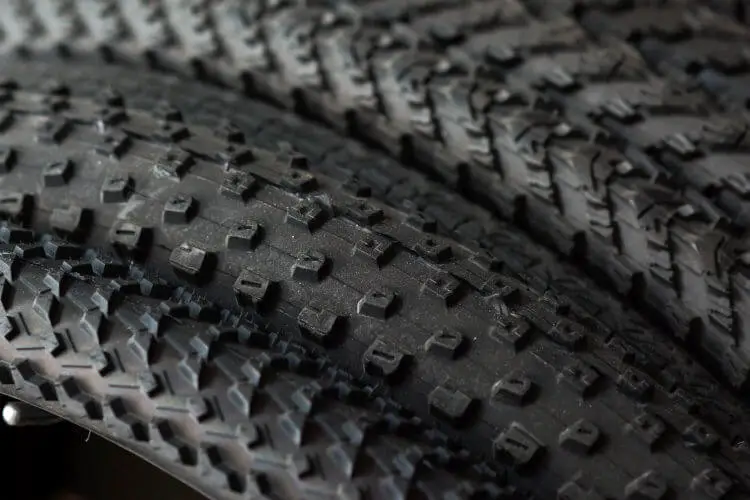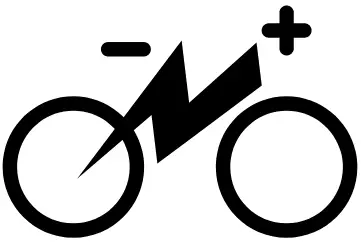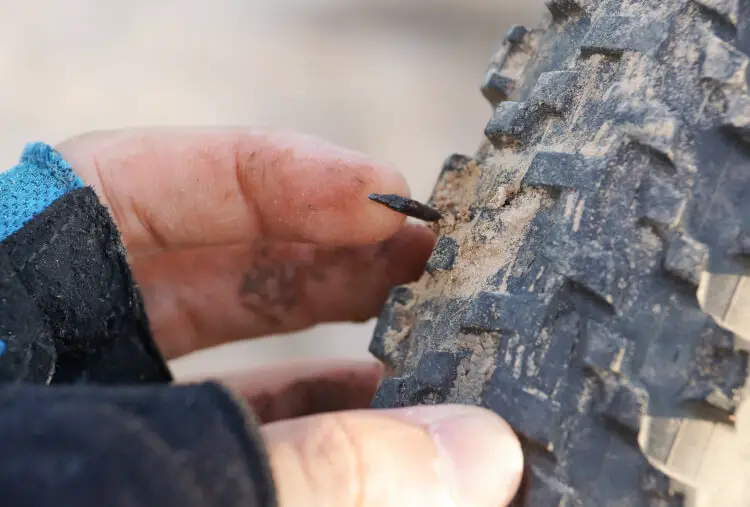The dreaded flat comes in a couple of varieties and is a source of frustration for anyone who has ridden a bike. Every terrain has its nuisances and you’re likely to quickly come up against thorns on pretty much every bike trail.
Road cyclists are skirting around broken glass and nails, and debris often settles at the side of the road just where cyclists ride. While punctures from sharp objects are the most common form of flat, pinch flats can also stop you in your tracks.
While it’s possible to repair flats out on the trail or road, one must wonder if puncture resistant tires really work. We looked into the different types of puncture resistant tires, the best ones on the market, and some DIY alternatives.
Do puncture resistant tires work? Yes, puncture resistant tires work. Many riders experience fewer with puncture resistant tires. These tires work by either increases tire thickness or adding a protective layer inside the tire. Puncture resistant tubes, tapes, and sealants are also alternatives to prevent flats.
What Are Puncture Resistant Bike Tires?
Puncture resistant bike tires are just that – bicycle tires that are resistant to getting punctures.
There are two ways in which resistance is added to the tire:
- Increased tire thickness
- Addition protective layers inside the tire
The first way is simple. Increase the tire thickness to increase tire durability. Sharp objects are then less likely to penetrate the thicker rubber. The main downside to this method is that it creates a heavier tire.
The second method is to use an extra later of material within the tire itself. This layer (sometimes called a sub-tread layer or a puncture proof belt) is specifically engineered material aimed to give the tire added protection.
What this layer is made of changes from different models and different manufacturers, but many use a material called Kevlar. Kevlar is a synthetic fiber that is stronger than steel, which is quite appealing when you want to avoid sharp objects.
Some models, like Bell’s Road Tires, use Kevlar as a layer on the bottom of the tire, but you can also find models that use it in bead as well.
The construction of a tire is quite technical and each tire company will have a range of tires appealing to different types of riders. The materials used, level of resistance, and level of protection will vary from each model. You can a sample of different construction in Kenda’s Casing Technology chart.
While the models target different types of riders, the industry is constantly moving towards creating the toughest material at the lightest weights.
Do Puncture Resistant Tires Actually Work?
You might be wondering if puncture resistant tires actually work, or if they are some type of marketing hype.
The short answer is yes – puncture resistant tires work and work quite well. Many riders have experienced much fewer flats since upgrading their tires to be puncture resistant. Some have even gone thousands of miles flat free.
Keep in mind, this doesn’t mean you will never get a flat. No tire is perfect and there are sometimes really nasty items on the road that will puncture even the toughest tires.
Other times you will get flats on puncture proof tires as your tires get worn down. Naturally, the more you wear your tires, the less durable they will be.
Which Puncture Resistant Tires Are Best?

Not all puncture resistant tires are created equal. Some will be more durable than others, but durability does come with a cost. We’ve sorted out the pros and cons of the most popular tires.
Continental Gator Skin
The best selling puncture resistant tire for road bikes is the Continental Gator Skin. Pretty much all riders at some point try these on.
Gator Skins incorporates a densely woven polyester that Continental use in car tires. The strength and durability make these tires a great choice, especially as the sidewall is also very well protected.
To achieve this durability, they use a material called Dura Skin which is a polyamide fabric used on the sidewalls. These are a good all-round tire that offers a great balance. While they are a little heavier than many tires, they offer decent performance and good protection
Schwalbe Marathon
If you care most about durability over performance, then Schwalbe Marathon tires may be exactly what you need. These tires are known to be the most puncture resistant tires on the market today.
However, the increased toughness will mean increased weight and a higher price tag.
As one rider put it:
I’d only recommend them if you only care about reliability. Heavy, slow, and rough riding, but damn reliable.
Schwalbe does claim that their tires built with the SmartGuard belt “does not increase rolling resistance” and that “the Marathon Plus rolls as easily as a tire without protection”. The protective layer on the Schwalbe is made up of recycled latex a material that has more give than other protective guards.
Many riders also feel confident riding with these tires in wet conditions. One of the downsides though is that these tires can be more difficult to mount.
Tubeless and Punctures

The emergence of tubeless tires, first in mountain bikes, then on road bikes, has been one of the biggest developments in the tire industry.
While it’s still possible to get punctures with tubeless, they are a lot rarer. There is no tube to pierce, but it’s still possible to puncture the tire itself instead of the tube.
Along with some added protection, there is often a weight reduction too. The removal of the tube lightens the overall weight in many cases.
It’s hard to declare that tubeless are lighter all the time, as there are lots of variables involved (including the amount of sealant applied). In most cases though, there will be a slight weight reduction which is particularly noticeable on road bikes.
Tubeless tires are airtight once they are fitted, which can be a time-consuming process. Once fitted, you can be sure to see a reduction of punctures in both mountain and road bikes.
Some wheels and tires can be adapted to become tubeless, but it’s important to check your model to ensure it’s compatible. You can also buy tubeless-ready rims such as the Mavic Deemax which will make fitting a simpler task.
The lack of tube also helps with speed and rolling resistance as there is no friction created between the tire and tube. To prevent punctures to the tire, a sealant is placed inside which fills in puncture holes as soon as they happen.
Punctures can still occur, but snake bites are no longer an issue as there is no tube to catch on the rim. Smaller puncture holes are also filled quickly with the sealant.
For road bikes, Kenda’s KSCT and Continental’s Grand Prix are good options. For Mountain Biking, Maxxis produces very good tires and has a solid history in tubeless. While there are lots of elements to consider in tire choice beyond puncture resistance, we feel Maxis Minion is an excellent robust tubeless tire.
Puncture Resistant Tubes, Tape, and Sealant Alternatives
When we look at puncture resistance clincher tires, we are looking largely at protecting the tube. But what if the tube didn’t need protecting?
Some of the best and most innovative alternatives to puncture resistant tires focus solely on adding resistance to the tubes. This can allow you to keep running your favorite tires while keeping the punctures down to a minimum.
Slime Tubes
Slime Self Sealing Tubes are pre-installed with a sealant that closes the holes as soon as punctures occur. It works in a similar way as the sealant in tubeless tires, but on the tube rather than the tire.
These tubes don’t offer 100% protection, but they will reduce your punctures, especially on smaller holes. There is also very little difference in cost when compared to standard tubes, so effectively you’re gaining some protection without the cost of new tires.
TAC 9 Thorn Resistant Tubes
Some thorn resistance tubes increase the amount of rubber to add protection, rather than using a sealant. TAC 9’s Thorn Resist Tubes are 7 times thicker than a standard tube. While this makes the tube heavier, it’s a lot more durable.
These TAC 9 tubes are manufactured with high quality butyl rubber. They are particularly resistant to objects like thorns, stickers, sand burds, and goat head stickers. The added thickness also provides extra protection from the spoke nipples on the rim.
One thing you should know about TAC 9 tubes is that it’s even more important to maintain proper air pressure (see what’s a good ebike tire pressure).
If you’re racing, there are better options to give yourself some protection without the extra weight that comes with TAC 9’s. A slightly lighter option are the Sunlite Thorn Resistant tubes which offer thickness and support only at the bottom of the tire, saving some weight.
Rim Tape
While tires are vulnerable to sharp objects, you can also get punctures from the sharp objects on the inside of the rim. The ends of spokes and other shards can pierce the tube, particularly on heavier rides.
Rim Tape is an excellent way to prevent this. It works by covering the area where something sharp might penetrate. Rim Tape works with both mountain bikes and road bikes and is a light-weight, low-cost option to consider.
Adding Sealant
If you’re happy to take on a small DIY project, it’s actually possible to add sealant to a tube itself. One such sealant is No Tubes Tire Sealant.
From the video below, you can see how effective it is against nails.
This sealant is quite handy. It does prevent flats, but the other huge benefit is that it allows you to use your existing tires and tubes of your choice.
Should You Invest in Puncture Resistant Tires?
If you’re are concerned about punctures, puncture resistant tires will certainly help. While these tires do cost more, you will be able to save money on tubes and you can’t be the convenience. Fixing a flat on the trail or on your commute can be a huge hassle.
Price aside, there are other considerations. Every tire is different, but you should pay attention to things like weight, rolling resistance, grip, and your ride.
If you want an easy more affordable option, Gator Skins are a good choice. For maximum protection, go with the Schwalbe Marathon tires instead.
To maximize savings, you can definitely make some big improvements if you’re willing to spend an hour to two in the garage. With some rim tape, thorn proof tubes, and sealant, you can be dramatically reducing your punctures for very little cost.

